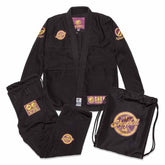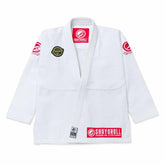Should You Train BJJ at a Small or Large Academy? Pros and Cons
No matter if you are new to Brazilian Jiu Jitsu (BJJ) or even a seasoned grappler looking to switch gyms. In such case, one question often comes up to practitioner’s mind: Should I train at a small academy or a large one? This decision can significantly impact your growth, experience and enjoyment in the sport. It does not matter whether you are rocking your first BJJ Gi or preparing for an IBJJF tournament. Choosing the right training environment is crucial.
In this detailed guide, we will explore the pros and cons of training at both small and large BJJ academies. It will analyze everything from class size, instructor access, and training variety, to competition focus, community culture and long-term progression. Moreover, this article will help you to make the final choice whether to join a small or a large academy.
What Defines a Small vs. Large BJJ Academy?
Before diving into pros and cons, let us clarify what we mean by small and large academies.
- Small BJJ Academy: Typically has fewer than 50 active members. A small BJJ academy has smaller class sizes (5–15 students per session) and fewer instructors.
- Large BJJ Academy: Often boasts 100+ members, multiple black belt instructors. A large BJJ academy has packed classes and a wider variety of programs and training options.
Both offer excellent training in Brazilian Jiu Jitsu. But the student experience can vary dramatically.
Pros of Training at a Small BJJ Academy
1- Personalized Attention from Coaches
One of the biggest benefits of a small academy is the direct access you have to instructors. Your coach is more likely to know your name, understand your game and give you specific feedback to accelerate your progress.
Personalized BJJ workouts and direct instruction can improve your technique faster than group-focused sessions at larger gyms.
2- Tight-Knit Community
Training at a small academy often feels like being part of a family. You will roll with the same partners regularly. Thus, building trust and camaraderie.
3- Low Student-to-Instructor Ratio
Fewer students per class means you won’t get lost in the crowd. You will receive more one-on-one instruction, corrections and help during drills.
4- More Mat Time with Higher Belts
In small gyms, it is common to train directly with higher belts—even black belts. These valuable rolls can fast-track your understanding of Brazilian Jiu Jitsu techniques.
Cons of a Small BJJ Academy
1- Limited Training Partners
You might find yourself rolling with the same few people repeatedly. It can limit your exposure to different styles and body types—important factors for growth and competition prep.
2- Fewer Classes and Specializations
Small gyms might not offer diverse classes like No-Gi BJJ, women’s-only classes, kids’ programs. Moreover, they often do not offer BJJ strength and conditioning sessions.
3- Limited Competition Team or Sparring Intensity
If your goal is to compete at a high level (e.g., IBJJF events), a smaller gym might not offer the intensity or breadth of training partners needed to push you to your limits.
Shop our IBJJF Approved Gi.
Pros of Training at a Large BJJ Academy
1- Wide Variety of Training Partners
More students = more styles. Training with different body types, sizes and levels of resistance helps you develop a well-rounded game.
For those preparing for high-level BJJ competitions, a large academy simulates the variety you will face on the mats.
2- Multiple Instructors and Class Options
Larger academies usually have several high-ranking black belts and a rotating teaching schedule. This gives you exposure to different philosophies, styles and techniques.
3-Specialized Programs
From BJJ Gi and No-Gi programs to strength and conditioning classes, open mats and even competition camps, large gyms offer comprehensive training opportunities.
4- High-Level Competitors
If you are serious about tournaments, larger academies tend to have well-established competition teams. All this push your pace and challenge your abilities.
Cons of a Large BJJ Academy
1- Less Personal Attention
In classes with 30+ students, it is easy to get overlooked. Unless you make an effort to stand out, coaches may not have time to give you personalized feedback.
2- Overwhelming for Beginners
Walking into a packed gym with dozens of experienced grapplers can be intimidating. You might feel lost or hesitate to ask questions.
3- Higher Membership Costs
Larger facilities with more instructors and amenities often come with a higher price tag. If you are just starting BJJ and testing the waters, this could be a factor.
4- Harder to Build Deep Relationships
Large gyms have plenty of people to train with. However, it can be more difficult to build the same kind of tight community bond found in smaller academies.
Choosing What’s Right for You: Key Questions to Ask
1- What are your goals in BJJ?
- Casual training for fitness and fun? A small academy might be ideal.
- Dreaming of gold at IBJJF Worlds? A large academy could give you the edge.
2- What kind of atmosphere do you thrive in?
- Do you like knowing everyone’s name and being part of a small group?
- Or do you enjoy constant challenge and anonymity?
3- What amenities and classes do you need?
- Or are you happy with one solid fundamentals class and some friendly rolls?
- Want open mat sessions, BJJ Gi and No-Gi training and BJJ strength and conditioning workouts?
Final Thoughts: It’s Not About Size—It’s About Fit
Ultimately, the best academy for you is the one that aligns with your goals, personality and schedule. A smaller gym may provide the close attention and sense of belonging that accelerates your learning. However, a larger one may challenge you with variety, intensity and a competition-ready environment.
Whichever you choose, remember this: Consistency is king in Brazilian Jiu Jitsu. It does not matter whether you are training in a small studio with 10 students or a mega academy with 200. What matters the most is showing up, putting in the work and rolling with intention.
Gear Up for Your Journey
No matter where you train, make sure you’re equipped with the best BJJ Gi, rash guards, and grappling gear to stay comfortable and perform at your best. Proper attire not only improves your performance but it shows respect for the art and your training partners.
Looking for premium, IBJJF-approved BJJ gear? Check out our latest collection of ranked rash guards, competition-ready BJJ Gis, and durable No-Gi sets at Novakik BJJ designed for grapplers of all levels.
Still unsure which path is right for you? Drop us a message or share your goals! We’ll help guide you toward the BJJ academy that fits your game and your lifestyle.







